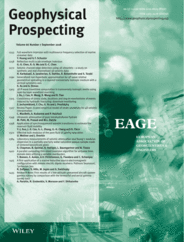
Full text loading...
We reformulate the original model of Hatchell and Bourne and Røste, Stovas and Landrø that couples fractional velocity change to subsurface strain via a fundamental constant R. The new model combines elastic compressibility of a dual‐porosity system for a sand–shale mixture with horizontal planes of inter‐granular weakness. The majority of observed R‐factor magnitudes from post‐stack 4D seismic data in both the reservoir and overburden can thus be explained. R is predicted to depend strongly on lithology and also initial strain state. The model is also extended to predict the observed angle‐dependence of time‐lapse time‐shifts from pre‐stack data. An expression for the gradient of time‐shift with incidence angle is obtained in terms of the background VP/VS, and also the ratio of tangential to normal compliances BT/BN representing loss or creation of inter‐granular coupling. If accurately estimated from data, this compliance ratio can be used as an additional parameter to assess the post‐production state of the overburden. It is concluded that whilst R remains the over‐arching parameter controlling the magnitude of time‐shifts measured from 4D seismic data, BT/BN is a subtler parameter that may also prove of future value.

Article metrics loading...

Full text loading...
References


Data & Media loading...

